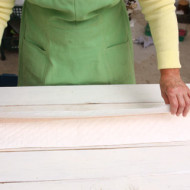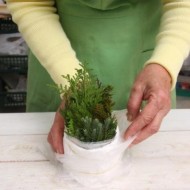How to propagate thuja by cuttings: 5 easy options step by step
Content
Dates of reproduction of thuja by cuttings
The success of the breeding of conifers depends on the correct timing of the procedure. Many gardeners claim that you can cut cuttings for further rooting at any time of the year.

However, it is best to carry out cuttings in spring or summer, so the plant will have more time to adapt and get used to new growing conditions. In the spring, cutting of cuttings is carried out until the beginning of active sap flow along the trunk and branches. The summer procedure is best performed in the last decade of June, when the second stage of plant growth begins.
Benefits of propagation by cuttings
When thuja is propagated by the seed method, it is possible to grow more hardy and viable plants. Nevertheless, the grafting method has its advantages:
- The ephedra retains almost all varietal characteristics obtained from the mother plant.
- The procedure does not take much time. You can get healthy and ready for transplantation to a permanent place of thuja growth after 2-3 years from the moment of harvesting the cuttings.
- Cutting is an easy and not burdensome way of propagation of cultivated plants.
Video "How to propagate thuja by cuttings?"
This video tells how to cut coniferous crops at home.
Cutting process
Breeding thuja with cuttings does not require much time and effort. Compliance with certain rules and recommendations will help to quickly and easily root a thuja twig. So, we bring to your attention step-by-step instructions for propagating thuja and other conifers by cuttings.
Harvesting shoots
Having decided on the timing of reproduction, they proceed to cutting cuttings. Harvesting of planting material is carried out on a cloudy or rainy day.
Young conifers are chosen for reproduction. The plant should be between 4-9 years old. The branch is cut or plucked with a sharp downward motion. The main thing is that the wood and the lignified bark of the mother ephedra remain on the branch. The longer the heel of the tree, the faster the rooting takes place.
Harvesting branches for rooting are made from strong and healthy-looking shoots. The optimum length of the cut is 10-15 cm. After separation from the mother shoot, the branches are cleaned of the exfoliated bark. All greens are removed from the lower part, the remaining needles are shortened by a third of the length.
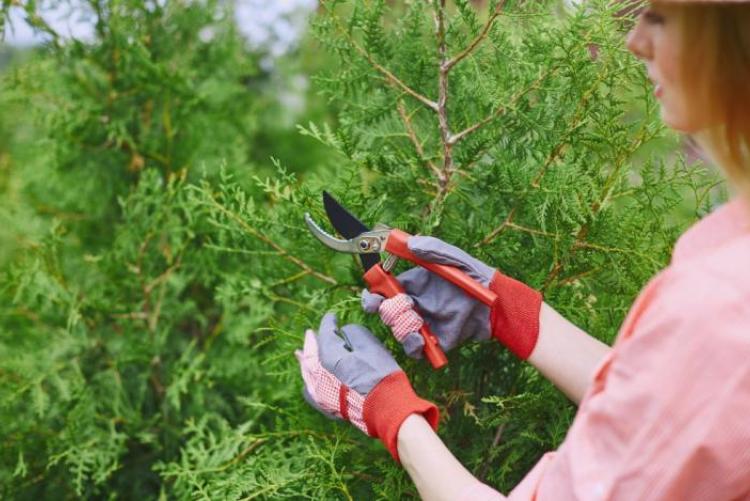
Rooting methods
The prepared cuttings are placed for 10-12 hours in a solution of a growth biostimulator prepared according to the instructions. It is recommended to use "Kornevin", "Epin", "Zircon", "Heteroauxin", etc.
Consider the most common and effective cultivation methods for coniferous crops.
In water
The easiest and least laborious way is the spring rooting of cuttings in water. For the procedure, you will need a transparent container with a volume of 500 ml and settled water at room temperature.
Thuja twigs are immersed in water in such a way that the heel of the tree is covered with liquid by 1, 5-2 cm. In one container there can be no more than 5 cuttings. Then the container with the planting material is moved to a cool, bright place. The water is changed as it becomes turbid. To prevent the development of infections, ordinary potassium permanganate is used.
In the substrate
To breed thuja in the substrate, you will need:
- mini greenhouse, small plastic containers or nurseries;
- nutritious soil mixture consisting of peat, leafy soil and river sand (2: 2: 1);
- settled or filtered water for irrigation.
Before planting, containers are treated with a disinfectant, and the soil is calcined in an oven or microwave. The bottom of the plastic container is laid out with a shallow drainage, on top of which soil is poured. The cuttings are planted in a well-moistened substrate. From above, the plants are covered with transparent, breathable material.
Rooting in the "diaper"
The rooting method in the "diaper" is similar to the previous version. The main difference is wrapping the cuttings in moss spread on the fabric. The algorithm of actions is as follows:
- Spread a piece of fabric on a flat, horizontal surface. The optimal length is 50 cm, width is 20-30 cm.
- Spread moss moss along the entire length of the fabric, stepping back 10-15 cm from the top edge.
- Put thuja twigs on top of the sphagnum, keeping an interval of 2-3 cm between them. Make sure that the green part of the plants does not come into contact with wet moss.
- Cover the moss and thuja branches with the bottom of the fabric. Roll the fabric into a roll and wrap in plastic wrap.
- Move the structure to a cool, bright place.
- Prepare a piece of fabric
- Spread the moistened moss evenly
- Put thuja twigs on top of the moss
- Roll up the "cocoon"
"Wick" rooting
The next option is "wick" rooting, for which you need to take a glass jar with a volume of 500 ml, two plastic cups, a small piece of cloth, fertile soil mixture and water.
A small hole is made at the bottom of one of the plastic cups, where 1/3 of the fabric is pulled. Then the fabric is evenly distributed over the bottom of the container. A nutritious substrate is poured on top. The cuttings are planted in a humidified environment.
A glass jar is filled with water. A glass with cuttings is placed inside the jar. Note that the remaining fabric must be submerged in the water. The second glass is used to cover the aerial part of the thuja twigs.

In potatoes
Some gardeners use a non-standard rooting method - in potatoes. There is an opinion that starch and other nutrients of the root crop contribute to the rapid formation of roots on the thuja.
The potatoes are thoroughly washed, while removing the eyes. Holes 4–5 cm long are made in root crops. A “woody heel” and a lignified stem of the cutting are placed in each hole. The potatoes are rearranged in wooden boxes with a fertile substrate. Each root vegetable is covered with a plastic bottle, from which the bottom is pre-cut.
Watering plants is carried out through the neck of the bottle. The cover can be removed to allow fresh air to enter the greenhouse.
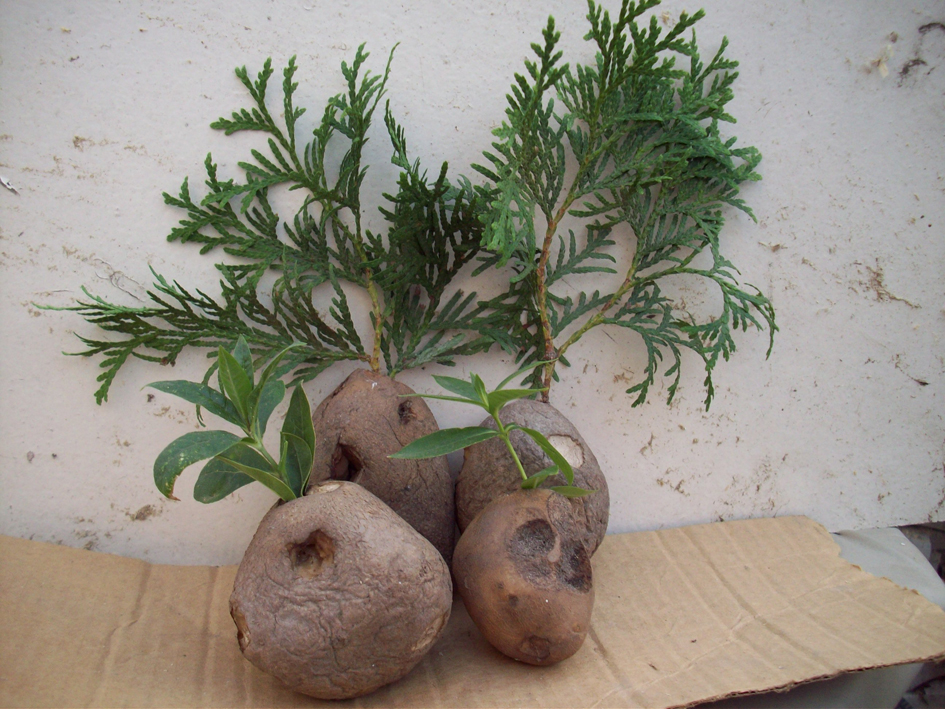
Rooting care
During rooting, it is important to monitor the humidity and air temperature in the room. So, the air humidity should be in the range of 70–75%, and the temperature - from +18 to +23 ° C. Plants need diffused light. Direct sunlight is dangerous because it can cause a burn on the aerial part of the thuja.
Watering is carried out from a spray bottle, avoiding the ingress of moisture on the needles and wood heel.It is necessary to moisten the plants as the upper layer of the substrate dries completely, if we are talking about rooting in the soil mixture. From time to time it is recommended to remove the upper shelter so that the plants can receive a portion of fresh air.
Growing cuttings
Home-rooted cuttings are characterized by weak adaptive abilities and low survival rate. For this reason, the plants require rearing.
Thuja cuttings are transplanted into flowerpots and exposed to the open air. Ephedra should grow in partial shade. Periodically, the plants are watered and fed. Be sure to remove the weed grass and loosen the soil. For the winter, young trees are insulated. You can transplant to a permanent place of growth after 2-3 years.
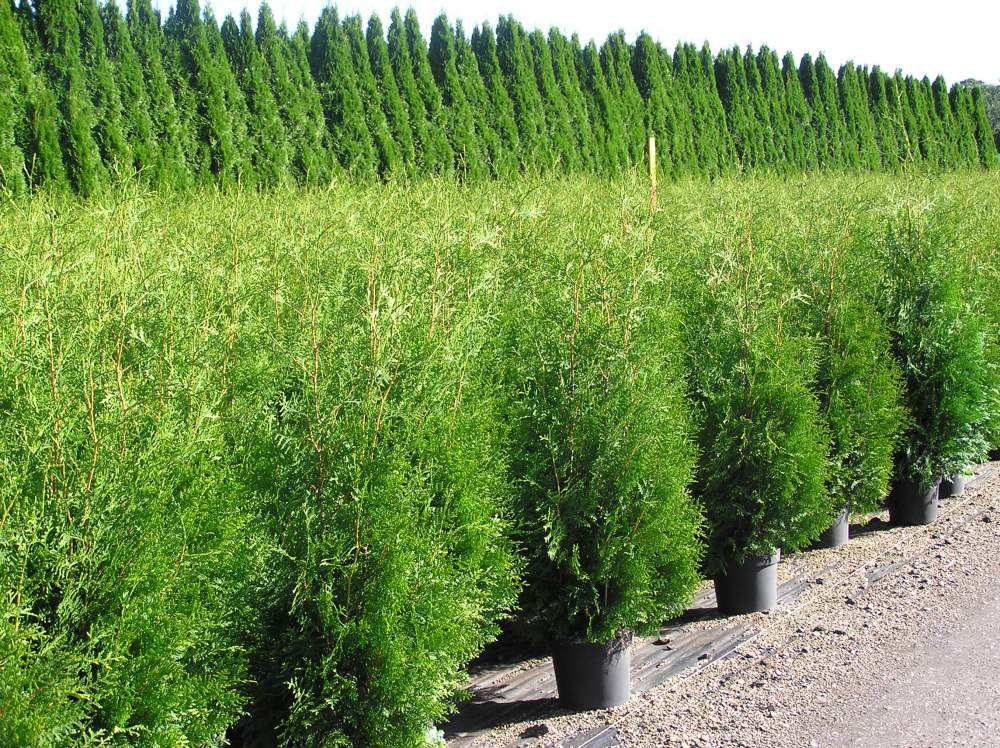
Care after rooting
It is better to root autumn branches in spring, and spring branches, respectively, in autumn. For planting a seedling in open ground, a sunny place with a light afternoon partial shade is selected. For growing coniferous crops, a fertile site is suitable, where organic fertilizers have previously been applied. For example, 1 bucket of peat is taken for 1 m² of the plot.
A seedling planted in open ground requires some care. The main care activities are watering, loosening and mulching the soil, fertilizing, pruning and wintering. The irrigation regime, the fertilizing schedule, the pruning scheme and the features of preparation for wintering are selected taking into account the varietal characteristics of the grown thuja.
Thuja is one of the most popular coniferous ornamental crops. The breeding options described in our article can be useful to both experienced and novice gardeners.

